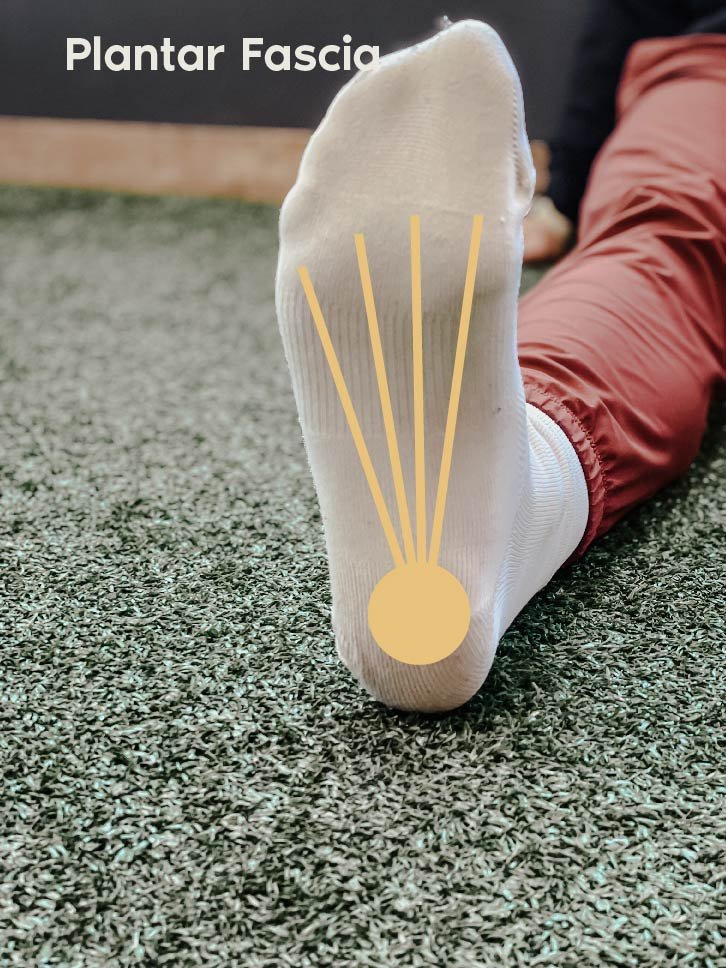Why Orthotics Aren’t the Solution to Your Plantar Fasciitis
What’s the first think people tell you to do when you get plantar fasciitis? Yup…more than likely they immediately say, “you should get orthotics!” This SEEMS like such an appealing answer, support the arch the way your foot is supposed to be and BAM your pain is gone and you’re good to go. In this blog post, we’re going to present the argument as to why this isn’t the direction you should go or at least why it isn’t the only thing you should do to truly solve your plantar fasciitis. We’ll present 3 problems and the solution to plantar fasciitis as well as at the bottom we’ve included a free download that has 3 exercises to prehab your plantar fascia.
Problem 1 - Your foot is supposed to move
Photo showing where the plantar fascia runs, from the heel to the balls of your feet.
One problem with the idea of finding the ‘right posture’ for your foot is that there isn’t a right posture! Your foot has no less than 33 joints…does that seem like something that shouldn’t move to you? Namely, your foot flattening and then your arch lifting are BOTH incredibly important to proper foot function. When you move, your foot should be moving from flat to arched (pronated to supinated) in order to store and release energy and make you athletic. If you foot is too rigid, it’s hard to be athletic. So the first problem is that orthotics may not be the way to go long term if you want a healthy and mobile foot.
Problem 2 - Getting short term relief
One thing orthotics can do for plantar fasciitis is provide relief. Here at The Movement, we belief that this CAN be a powerful piece of the puzzle for some people when it has this effect. However, the issue is JUST getting relief. Oftentimes this seems like a fix but ends up only being temporary, so the problem comes back and you end up stuck and uncertain as to how to move forward. Getting that short term relief can be helpful IF it’s followed up with a plan to solve the real issue.
Problem 3 - Not solving the real issue
Photo showing toe extension winding up the plantar fascia. This is what usually triggers discomfort and is what needs to be prepared for.
We’ve just identified that plantar fasciitis is not usually SOLVED by orthotics. This is because normally there’s a ‘load tolerance’ issue that still hasn’t been addressed. What do we mean by this? Oftentimes pain problems like plantar fasciitis occur because there is more ‘load’ or ‘stress’ on the tissue than it’s prepared to tolerate. This is demonstrated in this photo pictured here. So although orthotics can sometimes help relieve symptoms, they don’t do much to change that threshold. This means, once you go and try that same activity again there’s a high likelihood of flaring your plantar fasciitis up again.
The Solution - Building up your plantar fascia
The way to solve the problem is to build this tolerance threshold up so that there’s more ability for it to withstand load. When it comes to the plantar fascia, there are particular forces that load the plantar fascia that you’d need to work on. Pictured here, the plantar fascia is stressed when the toe is extended and the muscles that propel you forward are activated. This would be the top of a heel raise or walking forward. Typically, we’d start with movements and exercises that load this mechanism at a low level and then build up to higher intensities over the course of a treatment plan. Further, the plantar fascia is loaded when the foot is flattened or pronated, so we’d want to slowly introduce more and more of this type of movement. This occurs naturally when you squat and things of that nature.


